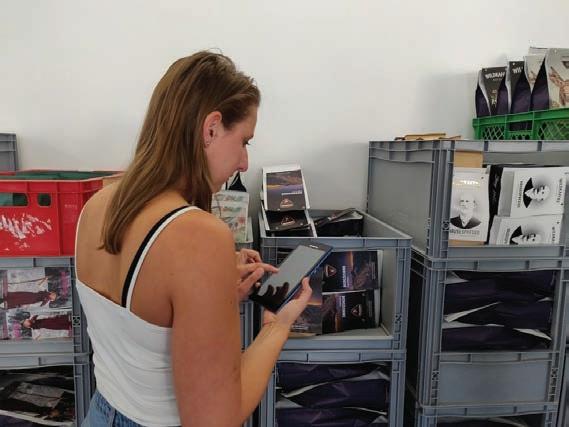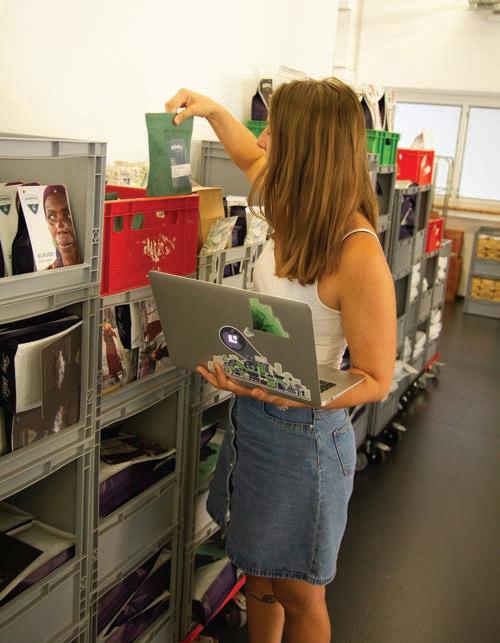
6 minute read
ACCORDING TO PLAN
Cropster Order to Roast and eCommerce powers effective roastery operations
CROPSTER ORDER TO ROAST AND ECOMMERCE SOLUTIONS CREATE CONNECTIONS ACROSS A COFFEE ROASTING BUSINESS, FROM POINT OF SALE RIGHT THROUGH TO PRODUCTION PLANNING AND OPERATIONS.
According to industry veteran Marcus Young, most coffee businesses he speaks to look very different to how they did two years ago.
“Almost every coffee business – with some exceptions to the rule – fundamentally changed due to COVID. Many roasters focused on selling wholesale coffee – offering coffee in bulk five pound or two-to-three-kilogram bags – distributed to cafés and restaurants, with smaller retail orders worked around those. That changed when almost every café on the planet closed overnight,” Young tells Global Coffee Report.
“The roasters that could adapt their sales and directly reach consumers were able to pivot and weather the storm. But it meant that their production processes fundamentally changed. Packaging a 2000-kilogram-roast day in two-to-three-kilogram bulk bags is much easier than packaging 1000 kilograms into 250-gram retail bags. It was important for roasters to have a system that could help them understand where those resources need to be deployed.”
Coffee software solutions supplier Cropster’s Order to Roast feature captures information from coffee orders and converts them into flexible production plans. Whether the order is placed online, over the phone, or in person with a sales representative, it just needs to be entered into the system. This calculates what and how much green coffee needs to be roasted to deliver the order.
After nearly 20 years in coffee working in roasting, retail cafés, and green coffee in the US and East Africa, Young joined Cropster in July to help Cropster deepen its coffee and market knowledge. He says as part of an integrated roastery solution, with inventory and quality management built in, Order to Roast saves time, improves consistency, and reduces errors and admin tasks across the business.
“When I’m talking to coffee roasters about Order to Roast, I ask them how long it usually takes each production day to gather orders, plan production, and put it in a system the roasting and fulfillment departments can use. The answer is usually anywhere from 45 minutes to two
eCommerce enables roasters to funnel all orders through one channel, which Order to Roast can use to automate production plans.
hours. That manual planning is a huge drain on human resources. The time savings Order to Roast offers, creating a production plan that just needs a quick review, are significant,” Young says.
“There can be three or more single origin coffees in a blend, so when manually calculating production, you need to calculate the percentage of each coffee in each blend, how much of each needs to be roasted based on weight loss percentages, and incorporate all of that all into a roast plan. It’s also easy to
make mistakes when manually entering that much information.”
Order to Roast also offers businesses flexibility in what they offer and how they plan their production. “You can add orders to your production at the ninth hour, and it makes it possible to offer ‘flexible’ products on your website too, like a ‘Roaster’s Choice’ that rotates every week. As soon as those orders come in, Order to Roast communicates that to the green inventory management so they can stay on top of what it has in stock and when to arrange new orders and samples,” Young says.
Order to Roast features direct integration with online shops like Shopify or WooCommerce, as well as Cropster’s own full-feature business-to-business (B2B) wholesale and consumer retail shop solutions. This means orders placed online are directly fed into Order to Roast without the need for manual entry.
“The demand when we launched the wholesale shop was tremendous. When I came onboard, we had a significant waiting list of customers to work through. We’ve now caught up, but it’s still keeping us busy fielding calls, providing demos, and assisting with shop setups,” Young says.
“Coffee has seen the success of eCommerce in the business-to-consumer (B2C) realm for a long time now. During COVID, selling coffee to customers online was a major boost to companies that were well established there. But there’s been a gap in where to gather your wholesale or B2B orders in one centralised location.”
Traditionally, Young says coffee roasters have received orders from a number of sources and it can be a challenge to aggregate them all. eCommerce solves that issue by having orders flow in through one stream and portal, even if the client prefers to stick to traditional ways of ordering.
“A roaster can now provide their wholesale customers with a simple online ordering portal. But because change can be difficult for some businesses that are used to ordering their coffee in a certain way, for example, a bakery that’s placed an order vie email every Tuesday morning for the past few years,” Young says.
“If they prefer to still call, email, or text, they can. Customer service at the roastery would enter their order the webshop for them, so it’s still within the ecommerce ecosystem which then means it’s fed through Cropster in a really seamless way for the production team.”
Cropster simply needs a list of the roaster’s products to setup the B2B online store, which it can then integrate to many existing accounting, shipping, and fulfillment systems. Coffee roasters can customise the webshop with their own logos, colours, or additional information on the included products.
“Time is the greatest resource for most companies, and many just haven’t had enough time to invest in developing their own robust eCommerce system, and those that have usually focused on B2C channels. Wholesale has different challenges, and we’ve made it so quick and simple for roasters to introduce an online store,” Young says.
“We’ve seen a lot of folks come on board that feel like it’s freed up their customer service staff to actually spend more time on the customer, instead of just taking incoming calls and manually pushing orders into the system.”
Cropster’s eCommerce solutions have attracted customers across a range of sizes and areas of focus, which Young says makes it hard to define a target demographic for the service. However, a trend he notices in customers is a desire to facilitate growth and enter new markets and business channels.
“It’s a solution that’s affordable and works well for companies that are just getting started, maturing businesses focused on bringing on more wholesale accounts, and established roasters who see the benefit in an off-the-shelf solution to streamline their complex production planning,” Young says.
He adds that eCommerce will continue to become more robust and an even bigger part of the coffee industry, and Cropster will continue to advance its digital services and solutions to match.
“We’re just at the beginning of the eCommerce solutions Cropster will offer, with the first version of this product already working for a lot of people,” Young says.
“Businesses that roast to order are the ones making the best use out of Cropster eCommerce and Order to Roast for now. So, we are focusing on developing feature-rich systems that also cater to companies that roast against set inventory levels.”
Cropster will also develop more robust reporting, tailored to people with different roles in the production room.
“From my perspective, the core of eCommerce is the ability to link an online store directly to your production, to synchronise those orders and aggregate them into what the folks working in production actually need,” Young says. GCR

For more information, visit www.cropster.com
Cropster’s eCommerce and Order to Roast feature can be integrated with software systems across a coffee roaster’s business.










